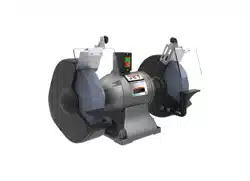Loading ...
Loading ...
Loading ...

11
Table 1 shows the correct size to use depending
on cord length and nameplate ampere rating. If in
doubt, use the next heavier gage. The smaller the
gage number (AWG), the heavier the cord.
Ampere
Rating
Volts
Total length of
cord in feet
More
Than
Not
More
Than
120
240
25
50
50
100
100
200
150
300
AWG
00 06 18 16 16 14
06 10 18 16 14 12
10 12 16 16 14 12
12 16 14 12
Not
Recommended
Extension Cord Recommendations
Table 1
6.3 Voltage conversion
To change voltage input to 230V on the IBG-8 and
IBG-10:
1. Turn grinder over and remove the base plate.
2. Rewire the leads according to the appropriate
diagram in sect. 13.0.
3. Remove the existing plug from the grinder
cable and attach a UL/CSA listed plug
designed for 230V power.
7.0 Operation
A bench grinder is designed for hand-grinding
operations such as sharpening chisels,
screwdrivers, drill bits, removing excess metal, and
smoothing metal surfaces.
A Medium Grain Abrasive Grinding Wheel is
suitable for rough grinding where a considerable
amount of metal must be removed or when
obtaining a smooth finish is not important.
A Fine Grain Abrasive Grinding Wheel should be
used for sharpening tools or grinding to close size
tolerances because it removes metal more
gradually for precision grinding and achieves a
smoother finish.
Always use approved safety
glasses or face shield while operating grinder.
Failure to comply may cause serious injury.
7.1 On/Off Switch
IBG-8, IBG-10: Pull the paddle switch (A, Figure 9)
to start grinder, push to stop. The safety key (A
1
)
can be removed to prevent unauthorized use of the
grinder. The safety key must be inserted to restart
the grinder.
IBG-12: Push green button to start grinder. Push
red button to stop.
On all models, when the stop
button is pushed, the wheels may take a few
moments to completely stop.
Note: After extended operation, the grinder
housing may be warm to the touch.
Figure 9: safety key
7.2 Precautions
1. Before starting the grinder, turn the wheels by
hand to verify that they are clear of
obstructions and they turn freely. The tool
rests and spark guards should not touch the
wheel.
2. Keep tool rests and spark guards to within
1/16" of the grinding wheel.
3. Turn on the grinder and allow it to reach full
running speed before starting to grind.
4. Adjust the eye shields as needed.
5. Keep a steady, moderate pressure on the
workpiece and keep it moving at an even pace
for smooth grinding. Pressing too hard
overheats the motor and prematurely wears
the grinding wheels. Note the original bevel
angle on the item to be sharpened and try to
maintain the same shape. The grinding wheel
should rotate into the object being sharpened.
6. If grinding a narrow workpiece, slide it laterally
across the width of the wheel. Using the full
width of the wheel will help prevent a groove
from forming at one place on the wheel.
7. Keep the water pot filled with water and dip
your work into it regularly to prevent
overheating. Overheating can weaken metals.
Do not apply water directly to the grinding
wheels.
8. Do not use the side of the grinding wheel; this
puts dangerous stress on the wheel.
9. When the wheel becomes loaded or dull, use
an approved grinding wheel dresser and dress
the wheel face.
Loading ...
Loading ...
Loading ...
